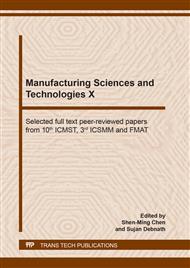p.91
p.97
p.103
p.111
p.117
p.122
p.129
p.139
p.147
Effect of Coolant Type on Surface Roughness and RSM Modelling in Single-Point Diamond Turning of RSA443 Optical Aluminum
Abstract:
This paper is a presentation of a comparative study of the effect of water and kerosene coolants on surface finish during ultra-high precision diamond turning (UHPDT) of Rapidly Solidified Aluminium alloy (RSA 443). The percentage relative difference between the coolants’ surface roughness values is denoted by the ΔRa parameter. The accuracy of the Response Surface Method (RSM) in predicting surface roughness of water and kerosene-based results is investigated in this paper. The cutting parameters used in the investigation are cutting speed, feed rate and depth of cut. The Taguchi method was used to design the experiment since it provides relatively fewer experimental runs when compared to classical experimental design methods. Mean Absolute Percentage Error (MAPE) values are used to compare RSM’s surface roughness prediction accuracy on both water and kerosene-based results. It is observed that the surface roughness profiles for either coolant are similar, and the use of water coolant yields smoother surface finishes when compared to the use of kerosene. It is also observed that RSM displays better accuracy in predicting water-based surface roughness.
Info:
Periodical:
Pages:
117-121
Citation:
Online since:
June 2020
Authors:
Price:
Сopyright:
© 2020 Trans Tech Publications Ltd. All Rights Reserved
Share:
Citation:


